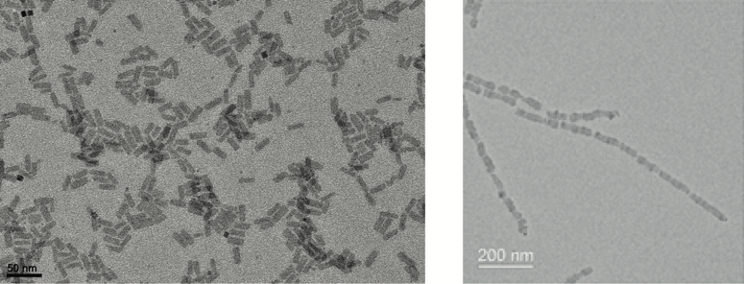Spontaneous electric polarization, a phenomenon called ferroelectricity, occurs in a material when the spatial distributions of positive and negative charges differ. It is therefore intimately related to the symmetry of the crystallographic structure of the material. Zinc-blende materials, such as CdSe, a very popular semi-conductor, are not ferroelectric. However, researchers of the LPS and ENS Lyon discovered that CdSe nanoplatelets, atomically-thin plate-like particles, show a large permanent electric dipole moment. This unexpected property of CdSe nanoplatelets could explain their self-assembly into larger structures and could affect their outstanding opto-electronic properties.
CdSe nanoplatelets (flat nanoparticles) have extraordinary physical properties and are considered as future components for a wide range of applications such as light sources [1]. Although bulk CdSe is not ferroelectric, the presence of a permanent electric dipole in CdSe nanoplatelets was detected by an optical technique called “transient electric birefringence” (TEB): An electric field is transiently applied to a nanoplatelet colloidal dispersion in a solvent. When the field is switched on, the particles align and birefringence is observed. When the field is switched off, the particles re-orient randomly by thermal motion and the birefringence vanishes. The precise dynamics of these phenomena depends on the nanoparticle shape and electric properties. Comparing experiments with theoretical predictions thus allows extracting quantitative information on the particle polarization. This technique was applied not only to isolated CdSe nanoplatelets but also to nanoplatelet stacks (see Figure 1) whose dynamics and field response strongly differ due to their very different geometries. In the case of stacks, the sign of the birefringence signal depends on the field frequency (see Figure 2), a clear signature of the presence of an electric dipole moment on the nanoparticles. These complementary experiments provided both the direction and magnitude of the nanoplatelet electric dipole moment, which is surprisingly large (≈ 300 Debye) for such nanoparticles. The electric dipole of the nanoplatelets could arise from the recently observed, low-symmetry, twist deformation imposed by the dense layer of organic molecules that cover them [2]. This large permanent dipole impacts not only the optical properties of the nanoplatelets but also the way they self-assemble into large-scale ordered architectures like the stacks. This work also begs for further exploration of permanent dipoles in other nanoparticles as their importance may have been overlooked.
[1] S.Ithurria, B.Dubertret, J. Am. Chem. Soc., 130, 16504 (2008).
[2] S.Jana, M. de Frutos, P.Davidson, B.Abécassis, Science Advances, 3, e1701483 (2017).


Reference
Probing Permanent Dipoles in CdSe Nanoplatelets with Transient Electric Birefringence
I. Dozov, C. Goldmann, P. Davidson, & B. Abécassis
Nanoscale (2020)
doi:10.1039/d0nr00884b
